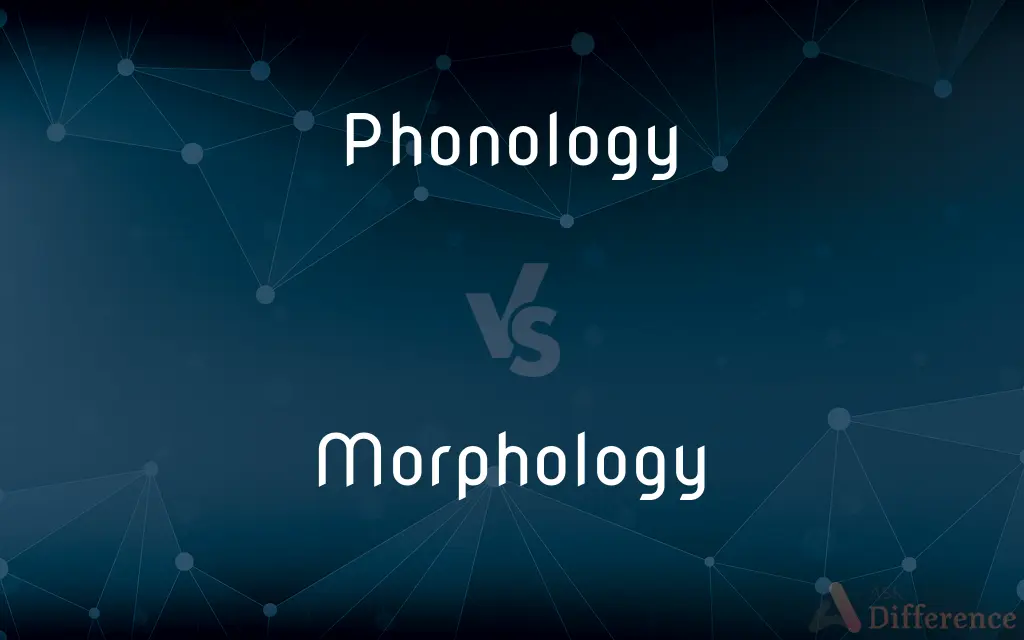Phonology vs. Morphology — What's the Difference?
Edited by Tayyaba Rehman — By Fiza Rafique — Updated on September 24, 2023
Phonology studies the sound systems of languages. Morphology examines the structure and formation of words. Both are crucial linguistic subfields, focusing on sound and word formation, respectively.

Difference Between Phonology and Morphology
Table of Contents
ADVERTISEMENT
Key Differences
Phonology is the study of sound patterns in languages, analyzing how sounds function within particular systems and languages. Morphology, in contrast, delves into the internal structure of words, exploring how they are formed and their relations to other words.
Phonology often considers the rules governing the distribution and sequencing of speech sounds. It looks at how sounds change and how they interact with each other. Morphology, on the other hand, looks at how words are constructed from morphemes (the smallest grammatical units) and how these pieces combine to give words their meanings.
In phonology, phonemes (distinct sound units) are central; they differentiate meaning. For instance, changing a single phoneme can alter a word's meaning. Morphology revolves around understanding how morphemes like prefixes, roots, and suffixes work together within a word.
Through phonology, we comprehend why certain sounds in a language are interchangeable or why some sounds are rarely combined. Morphology enlightens us about word formation, how complex words evolve, and how languages manage word modification.
For someone studying linguistics, phonology would offer insights into sound patterns and rules across languages. In contrast, morphology would provide an understanding of the intricacies of word formation and structure.
ADVERTISEMENT
Comparison Chart
Definition
Study of sound systems in languages
Study of word structures and formation
Central Unit
Phonemes (distinct sound units)
Morphemes (smallest grammatical units)
Focus
Sound patterns, distribution, and interaction
Word construction, relation, and meaning derivation
Examples
Vowel/consonant changes, stress patterns
Prefixes, suffixes, inflectional changes
Application
Understanding sound variations and rules
Understanding word formation and complexities of language units
Compare with Definitions
Phonology
The analysis of how sounds function within specific languages or systems.
Through phonology, we learn that certain sounds are distinctive in English but not in other languages.
Morphology
Concerned with word formation rules and processes.
Morphology explains how drink becomes drank in the past tense.
Phonology
The study of sound systems in languages.
Phonology helps us understand why cat and bat sound different due to different initial phonemes.
Morphology
Study of prefixes, roots, and suffixes in word construction.
Morphology breaks down disadvantage into the prefix dis- and the root advantage.
Phonology
Exploration of the rules governing speech sound distribution.
Phonology explains why certain sound combinations are impossible or rare in English.
Morphology
The study of the structure and formation of words in a language.
Morphology allows us to understand the components of the word unhappiness as un- + happy + -ness.
Phonology
Examination of sound patterns and their influence on language meaning.
Phonology investigates how tone differences can change word meanings in tonal languages.
Morphology
Exploration of how morphemes, the smallest meaningful units, combine in words.
Through morphology, we see how the word running is constructed from the root run and the morpheme -ing.
Phonology
Concerned with phonemes and their possible arrangements in languages.
In phonology, the change from pin to bin represents a phonemic change.
Morphology
The study of the forms of things.
Phonology
Phonology is a branch of linguistics that studies how languages or dialects systematically organize their sounds (or signs, in sign languages). The term also refers to the sound system of any particular language variety.
Morphology
A particular form, shape, or structure.
Phonology
The study of speech sounds in language or a language with reference to their distribution and patterning and to tacit rules governing pronunciation.
Morphology
The branch of biology that deals with the form and structure of organisms without consideration of function.
Phonology
The sound system of a language
The phonology of English.
Morphology
The form and structure of an organism or one of its parts
The morphology of a cell.
The morphology of vertebrates.
Phonology
The study of the way sounds function in languages, including phonemes, syllable structure, stress, accent, intonation, and which sounds are distinctive units within a language.
Morphology
(Linguistics) The study of the structure and form of words in language or a language, including inflection, derivation, and the formation of compounds.
Phonology
The way sounds function within a given language; a phonological system.
Morphology
(uncountable) A scientific study of form and structure, usually without regard to function. Especially:
Phonology
The science or doctrine of the elementary sounds uttered by the human voice in speech, including the various distinctions, modifications, and combinations of tones; phonetics. Also, a treatise on sounds.
Morphology
(linguistics) The study of the internal structure of morphemes (words and their semantic building blocks).
Phonology
The study of the sound system of a given language and the analysis and classification of its phonemes
Morphology
(biology) The study of the form and structure of animals and plants.
Morphology
(geology) The study of the structure of rocks and landforms.
Morphology
(math) Mathematical morphology.
Morphology
(countable) The form and structure of something.
Morphology
(countable) A description of the form and structure of something.
Morphology
That branch of biology which deals with the structure of animals and plants, treating of the forms of organs and describing their varieties, homologies, and metamorphoses. See Tectology, and Promorphology.
Morphology
The form and structure of an organism.
Morphology
The branch of linguistics which studies the patterns by which words are formed from other words, including inflection, compounding, and derivation.
Morphology
The study of the patterns of inflection of words or word classes in any given language; the study of the patterns in which morphemes combine to form words, and the rules for combination; morphemics; as, the morphology of Spanish verbs; also, the inflection patterns themselves.
Morphology
The branch of biology that deals with the structure of animals and plants
Morphology
Studies of the rules for forming admissible words
Morphology
The admissible arrangement of sounds in words
Morphology
The branch of geology that studies the characteristics and configuration and evolution of rocks and land forms
Morphology
Understanding of word modification and complexities in languages.
Morphology helps in comprehending the difference between writer and written.
Common Curiosities
What does phonology study?
Phonology studies the sound systems and patterns within languages.
Are phonemes central to phonology or morphology?
Phonemes are central to phonology.
What's the smallest unit in morphology?
The smallest unit in morphology is the morpheme.
How does phonology impact language meaning?
Phonology impacts meaning by differentiating words through distinct sound units.
Can phonology explain accents?
Yes, phonology delves into sound variations, which include accents.
What is the focus of morphology?
Morphology focuses on the structure, formation, and relationships of words.
How does morphology influence word meanings?
Morphology influences word meanings through the combination and structure of morphemes.
What's a common topic in phonology?
A common topic in phonology is the distribution and sequencing of phonemes in languages.
Can morphology explain word origins?
Yes, morphology can shed light on word formation and origins by analyzing its components.
How does phonology relate to pronunciation?
Phonology studies sound patterns, providing the foundation for correct pronunciation in languages.
Why is morphology crucial for language learners?
Morphology helps language learners understand word formation, enabling them to deduce meanings and create new words.
Does morphology study sentence structure?
No, morphology studies word structure. Sentence structure is studied under syntax.
Can morphology explain verb conjugations?
Yes, morphology examines verb forms and conjugations as part of word structure.
Do all languages have similar phonological rules?
No, phonological rules can vary significantly across languages.
How do phonology and morphology interplay in linguistics?
Phonology and morphology are distinct subfields, but they overlap when sound patterns (phonology) influence word formation (morphology).
Share Your Discovery

Previous Comparison
Diploma vs. Diplomate
Next Comparison
Send vs. SendingAuthor Spotlight
Written by
Fiza RafiqueFiza Rafique is a skilled content writer at AskDifference.com, where she meticulously refines and enhances written pieces. Drawing from her vast editorial expertise, Fiza ensures clarity, accuracy, and precision in every article. Passionate about language, she continually seeks to elevate the quality of content for readers worldwide.
Edited by
Tayyaba RehmanTayyaba Rehman is a distinguished writer, currently serving as a primary contributor to askdifference.com. As a researcher in semantics and etymology, Tayyaba's passion for the complexity of languages and their distinctions has found a perfect home on the platform. Tayyaba delves into the intricacies of language, distinguishing between commonly confused words and phrases, thereby providing clarity for readers worldwide.
















































